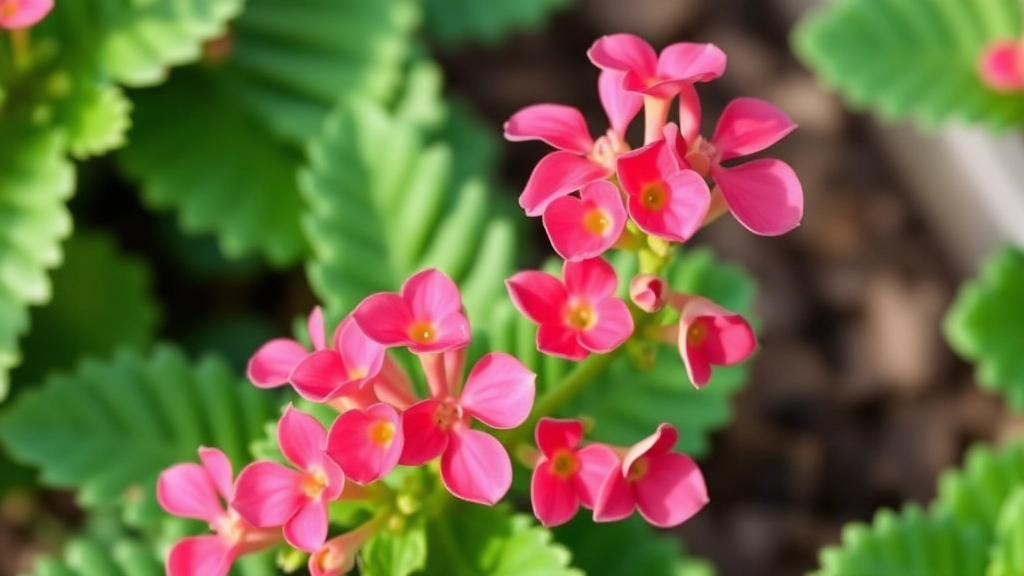Mastering Kalanchoe Care in Texas
If you’re looking to master Kalanchoe care in Texas, you’re in the right place. Texas’s unique climate can be a challenge, but with the right tips, your Kalanchoe can thrive. From understanding sunlight needs to adjusting your watering routine, I’ll guide you through everything you need to know to keep your Kalanchoe healthy and blooming all year round.
Sunlight Needs
First, let’s talk about sunlight. Kalanchoe plants love bright, indirect light, but Texas’s intense sun can be too much. Position your plants where they get morning sun and afternoon shade.
Watering Tips
Next, watering is crucial. In Texas, you’ll need to adjust based on the season—more frequent watering in the summer and less in the winter. Stick with well-draining soil to prevent root rot, and remember, less is more when it comes to water.
Best Varieties of Kalanchoe for Texas Gardens
When considering Kalanchoe for your Texas garden, you might wonder which varieties thrive best in this unique climate.
Kalanchoe is a resilient succulent that can bring vibrant colour and life to your outdoor space.
Top Varieties for Texas
- Kalanchoe blossfeldiana
- Known for its stunning clusters of small flowers, this variety blooms in a range of colours.
- It thrives in warm temperatures, making it ideal for Texas gardens.
- Kalanchoe tomentosa (Panda Plant)
- This variety features fuzzy, grey-green leaves with brown edges.
- It’s drought-tolerant and adds a unique texture to your garden.
- Kalanchoe luciae (Flapjack Plant)
- With its striking, paddle-shaped leaves, this variety is a visual standout.
- It prefers full sun and can handle the Texas heat well.
- Kalanchoe thyrsiflora
- Often referred to as “Mother of Thousands,” it produces beautiful clusters of flowers.
- It’s hardy and can adapt to various soil types in Texas.
- Kalanchoe beharensis (Elephant Ear Plant)
- This variety features large, velvety leaves and can grow quite tall.
- It’s perfect for creating a dramatic focal point in your garden.
Choosing the Right Variety
When selecting a Kalanchoe variety for your Texas garden, consider the following factors:
- Sun Exposure: Ensure the chosen variety can handle the amount of sunlight in your garden.
- Soil Type: Different varieties may have specific soil preferences.
- Water Needs: Understand the watering requirements to prevent over or under-watering.
By choosing the right Kalanchoe variety, you can enhance the beauty of your garden while ensuring these plants flourish in the Texas climate. For more detailed information, check out our complete care guide for Kalanchoe Panda Plant and our Flaming Katy Kalanchoe Blossfeldiana care guide.
Sunlight and Shade Balance for Kalanchoe in Texas
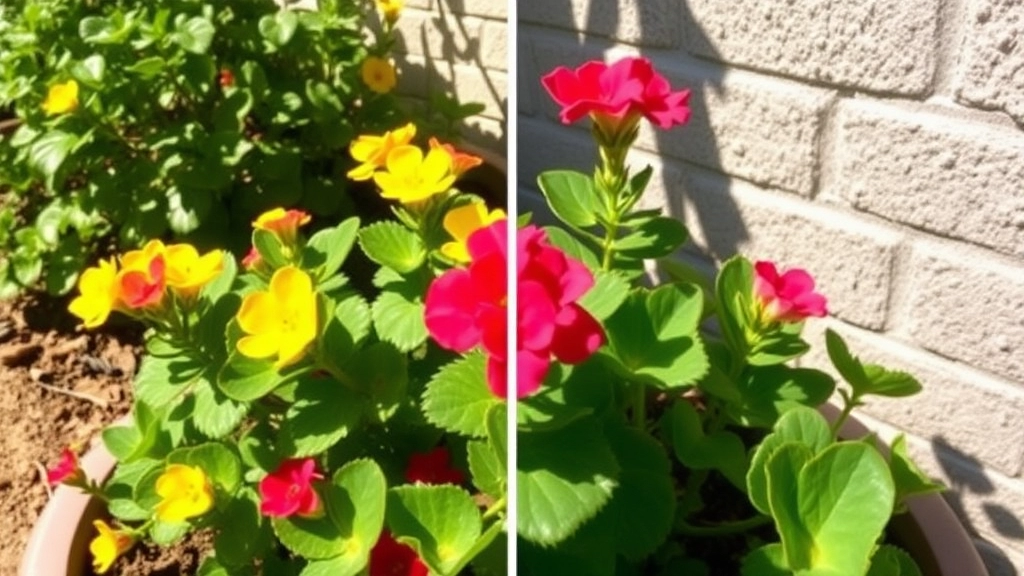
Are you wondering how to strike the perfect balance of sunlight and shade for your Kalanchoe in Texas?
These vibrant plants thrive in bright light but can be sensitive to the intense Texas sun.
Here’s how to get it right:
- Bright, Indirect Light: Kalanchoe loves bright light but prefers it indirect. A spot near a window with filtered sunlight is ideal. Think sheer curtains or a spot under a tree that lets some light through.
- Avoid Harsh Afternoon Sun: The afternoon sun can be brutal. If your Kalanchoe is outdoors, consider providing some shade during the hottest parts of the day. A simple umbrella or shade cloth can do wonders.
- Indoor Considerations: If you’re growing Kalanchoe indoors, a south or west-facing window works well. Just keep an eye on it; if the leaves start to look scorched, it’s time to move it back a bit.
- Monitor Growth: Watch how your plant responds. If it’s stretching towards the light, it’s craving more. If the leaves are wilting or turning brown, it might be getting too much sun.
- Seasonal Adjustments: As the seasons change, so should your plant’s location. Move it around as needed to ensure it’s getting the right amount of light throughout the year.
Adapting Watering Routines to the Texas Climate
As we delve into the specifics of caring for Kalanchoe, one critical aspect is watering.
Many Texas gardeners often wonder: How frequently should I water my Kalanchoe in this climate?
Understanding Texas Climate
Texas experiences a range of weather conditions, from scorching summers to mild winters. This variability directly influences how we approach watering our plants.
Key Considerations for Watering Kalanchoe
- Soil Type: Kalanchoe thrives in well-draining soil. Consider using a cactus or succulent mix to prevent water retention.
- Watering Frequency:
- During the hot summer months, water every 1-2 weeks.
- In cooler months, reduce watering to once every 3-4 weeks.
- Signs of Thirst:
- Leaves may appear wrinkled or shrivelled.
- The soil should be dry to the touch at least an inch down before watering.
- Time of Day:
- Water in the morning to allow plants to absorb moisture before the heat of the day.
- Avoid watering in the evening to prevent fungal diseases.
Adjusting to Humidity
Texas can also experience high humidity, especially in the spring and fall. In such conditions, ensure that the watering routine is adjusted:
- Monitor Moisture Levels: Use a moisture meter to gauge soil dampness.
- Reduce Watering: In humid periods, cut back on watering frequency to avoid overwatering.
For more detailed care tips, you might find our Ultimate Guide to Fuzzy Kalanchoe Care Tips helpful. Additionally, if you’re dealing with any specific issues, our article on Causes and Solutions for Black Spots on Kalanchoe Leaves could provide valuable insights.
Soil Requirements for Healthy Kalanchoe Growth
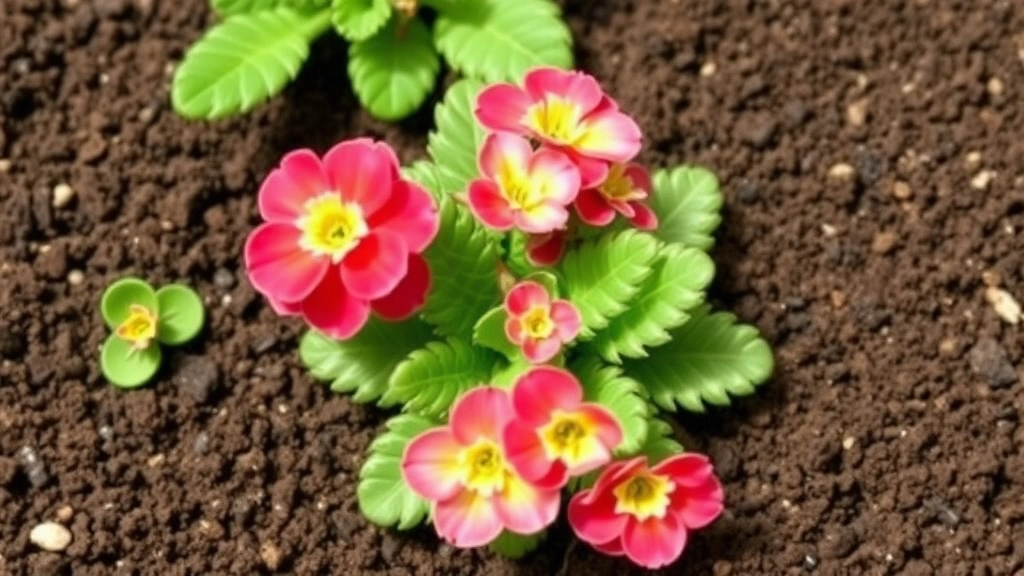
As we delve deeper into the care of Kalanchoe, it’s crucial to understand the specific soil requirements that will foster their growth in Texas gardens.
Choosing the Right Soil Mix
Kalanchoe thrives in well-draining soil, which is essential for preventing root rot. Here are some key points to consider:
- Cactus or Succulent Mix: Using a commercial cactus or succulent mix is ideal, as it provides the drainage Kalanchoe needs.
- DIY Soil Blend: If you’re feeling adventurous, you can create your own mix by combining:
- 2 parts potting soil
- 1 part perlite or pumice
- 1 part coarse sand
- pH Level: Aim for a slightly acidic to neutral pH level (around 6.0 to 7.0) to ensure optimal nutrient availability.
Importance of Drainage
Drainage is key to healthy Kalanchoe growth. Here’s how to ensure your soil drains well:
- Pot Selection: Choose pots with drainage holes to allow excess water to escape.
- Layering: Place a layer of gravel or small stones at the bottom of the pot to enhance drainage.
Regular Maintenance
Maintaining the right soil condition is essential for long-term health:
- Top Dressing: Consider adding a layer of fresh soil or mulch on top every spring to replenish nutrients.
- Check Soil Moisture: Regularly check the soil’s moisture level. If it feels dry an inch below the surface, it’s time to water.
Temperature Tolerance and Seasonal Adjustments
One of the primary concerns for Texas gardeners is how to manage temperature fluctuations that can impact Kalanchoe plants.
Temperature Tolerance
Kalanchoe is a resilient succulent that thrives in warm climates, making it a suitable choice for Texas gardens. However, it does have its limits:
- Ideal Temperature Range: Kalanchoe prefers temperatures between 60°F and 85°F (15°C to 29°C).
- Cold Sensitivity: Anything below 50°F (10°C) can stress the plant, leading to wilting or even death.
- Heat Resilience: While Kalanchoe can withstand high temperatures, prolonged exposure to extreme heat above 90°F (32°C) may cause leaf drop.
Seasonal Adjustments
Understanding seasonal changes in Texas can help you adjust care for your Kalanchoe:
How to Protect Kalanchoe from Texas Heat Waves
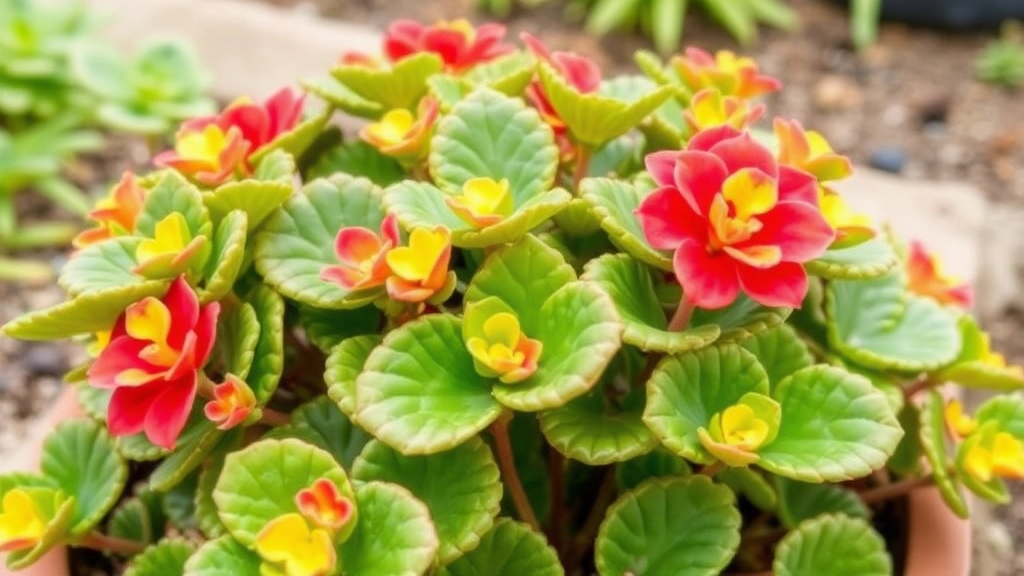
Ever found yourself worrying about your Kalanchoe during those scorching Texas heat waves? You’re not alone.
These beautiful succulents can struggle when the temperatures soar, but with a few simple strategies, you can keep them thriving.
Shade Strategies
- Move Them Indoors: If the heat is unbearable, consider bringing your Kalanchoe inside during peak hours.
- Use Shade Cloth: Create a shaded area using cloth or a garden umbrella. This can shield them from the harsh midday sun.
Water Wisely
- Morning Watering: Water early in the day to prevent evaporation. This gives your plants a good drink before the sun gets too intense.
- Check Soil Moisture: Stick your finger in the soil. If it feels dry an inch down, it’s time for a drink.
Mulching Magic
- Use Organic Mulch: A layer of mulch around your Kalanchoe can help retain moisture and keep roots cool.
Wind Protection
- Create Barriers: If your garden is exposed to hot winds, consider using fences or tall plants as windbreaks.
Monitor for Stress
- Watch for Signs: If your Kalanchoe starts drooping or losing leaves, it’s a sign they’re stressed. Adjust your care routine accordingly.
Preventing Overwatering and Root Rot in Humid Regions
Are you worried about your Kalanchoe plants suffering from overwatering or root rot in the humid Texas climate? You’re not alone. Many gardeners grapple with maintaining the right moisture levels for their beloved succulents.
Understanding Overwatering Risks
Kalanchoe is a resilient plant, but it thrives best with well-draining conditions. In humid regions, the risk of overwatering increases, leading to root rot, which can be detrimental.
Key Tips to Prevent Overwatering:
- Check the Soil Moisture: Always feel the top inch of the soil before watering. If it’s still moist, hold off.
- Use Well-Draining Soil: Opt for a cactus or succulent mix that allows excess water to escape easily.
- Choose the Right Pot: Ensure your pot has drainage holes. This prevents water from accumulating at the bottom.
- Water Sparingly: During the humid months, reduce your watering frequency. Kalanchoe can go longer without water than you might think.
- Observe Your Plant: Yellowing leaves or a mushy stem are signs of overwatering. Adjust your routine accordingly.
Creating a Balanced Environment
To keep your Kalanchoe thriving, it’s essential to strike a balance between humidity and moisture. For more detailed guidance, check out our Optimal Watering Tips for Healthy Florist Kalanchoe. Additionally, understanding the causes and solutions for dying Kalanchoe leaves can help you maintain a healthy plant.
Fertilizing Kalanchoe for Year-Round Blooms
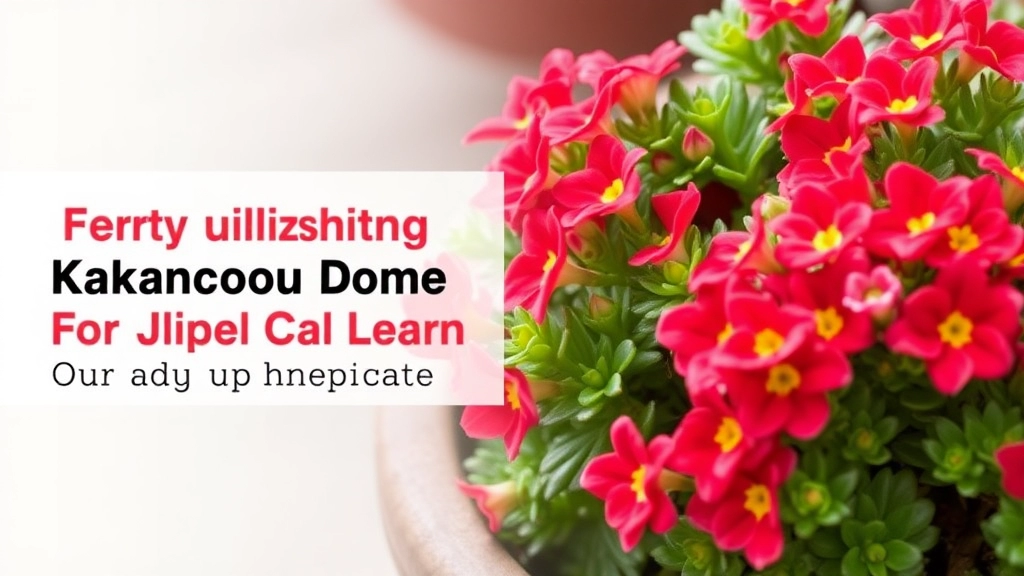
Are you wondering how to keep your Kalanchoe blooming beautifully throughout the year? You’re not alone! Many gardeners in Texas face the same challenge. The good news is that with the right fertilizing routine, you can encourage vibrant blooms and healthy growth.
Understanding Nutrient Needs
Kalanchoe is a tough little plant, but it still needs a little help from us to thrive. Here’s how to keep it well-fed:
- Use a Balanced Fertilizer: Look for a balanced, water-soluble fertilizer with an N-P-K ratio of 15-30-15. This will provide the right nutrients for flowering.
- Dilution is Key: Always dilute the fertilizer to half the recommended strength. Kalanchoe doesn’t need an overload of nutrients.
- Feed During Growing Season: Fertilize every 4-6 weeks from spring through late summer. This is when your plant is actively growing and needs those extra nutrients.
Special Tips for Texas Gardens
- Seasonal Adjustments: In the cooler months, reduce feeding frequency. Kalanchoe slows down in winter, so it doesn’t require as much food.
- Organic Options: If you prefer organic, try a liquid seaweed or fish emulsion. These options can be gentler and still effective.
- Signs of Nutrient Deficiency: Keep an eye out for yellowing leaves or stunted growth. These could be signs your Kalanchoe needs a bit more love.
Real-Life Example
I remember chatting with a fellow gardener who struggled to get her Kalanchoe to bloom. After switching to a balanced fertilizer and following a proper schedule, she saw a transformation! Her plants were bursting with colour in no time.
When cultivating Kalanchoe in Texas, pest and disease management becomes essential to ensure healthy growth and vibrant blooms. Many gardeners worry about the potential threats that can impact their plants, especially in a diverse climate like Texas.
**Common Pests to Watch For**
– **Mealybugs**: These small, white, cotton-like pests can cluster on leaves and stems, sucking sap from your Kalanchoe.
– **Spider Mites**: Tiny and often unnoticed, these pests can cause yellowing leaves and webbing.
– **Aphids**: These green or black insects can be found on new growth, damaging leaves and flowers.
**Signs of Disease**
– **Root Rot**: Caused by overwatering, this leads to mushy roots and wilting leaves.
– **Powdery Mildew**: A white, powdery fungus that appears on leaves, often due to high humidity.
– **Leaf Spot**: Dark spots on leaves can indicate fungal infections or bacterial issues.
**Preventive Measures**
– **Regular Inspection**: Check your Kalanchoe weekly for any signs of pests or disease. Early detection is key.
– **Proper Spacing**: Ensure adequate airflow between plants to reduce humidity and prevent fungal issues.
– **Avoid Overwatering**: Water only when the soil is dry to prevent root rot.
**Treatment Options**
– **Insecticidal Soap**: Effective against mealybugs and aphids, it’s a gentle option for your Kalanchoe.
– **Neem Oil**: A natural pesticide that can help manage a variety of pests.
– **Fungicides**: For fungal issues, apply as directed to control diseases like powdery mildew.
For more detailed guidance on preventing and treating these issues, you can refer to the [ultimate guide to growing Kalanchoe Pink Plant](https://planthq.org/ultimate-guide-to-growing-kalanchoe-pink-plant/) and [how to grow and care for flowering Kalanchoe Blossfeldiana](https://planthq.org/how-to-grow-and-care-for-flowering-kalanchoe-blossfeldiana/).
Potting and Repotting Tips for Texas Gardeners
So, you’ve got your Kalanchoe thriving, but how do you ensure it’s happy in its pot?
Potting and repotting can feel a bit daunting, especially in Texas where the climate can be unpredictable.
Here are some straightforward tips to keep your Kalanchoe flourishing:
Choosing the Right Pot
- Size Matters: Pick a pot that’s just a tad bigger than the current one. Too large, and the roots might struggle.
- Drainage is Key: Ensure your pot has drainage holes. Kalanchoe hates sitting in water!
Best Soil Mix
- Cactus or Succulent Mix: A well-draining mix is crucial. You can even make your own by blending regular potting soil with sand or perlite.
- pH Level: Aim for a slightly acidic to neutral pH (around 6.0 to 7.0).
When to Repot
- Signs to Watch For: If you notice roots poking out of the drainage holes, or if the plant seems root-bound, it’s time to repot.
- Best Time: Spring is ideal for repotting, as it allows your Kalanchoe to settle in before the heat kicks in.
How to Repot
- Prepare the New Pot: Add a layer of fresh soil at the bottom.
- Gently Remove the Plant: Carefully take your Kalanchoe out of its old pot. Loosen any tightly bound roots.
- Position the Plant: Place your Kalanchoe in the new pot and fill around it with fresh soil. Make sure it sits at the same depth as before.
- Water Lightly: After repotting, give it a gentle drink. Don’t drown it!
Aftercare
- Location Matters: Keep your newly potted Kalanchoe in a spot with bright, indirect sunlight for a week or so.
- Monitor Watering: Hold off on watering too much right after repotting. Let it adjust first.
Tips for Reblooming Kalanchoe in Texas Winters
As we transition into the cooler months, many gardeners wonder how to keep their Kalanchoe vibrant and blooming.
Understanding Kalanchoe’s Winter Needs
Kalanchoe, a popular succulent, can thrive in Texas winters with the right care.
Here are some essential tips for encouraging reblooming:
- Light Exposure:
- Ensure your Kalanchoe receives plenty of bright, indirect sunlight.
- If natural light is limited, consider using a grow light to supplement.
- Temperature Control:
- Maintain indoor temperatures between 60°F to 75°F (15°C to 24°C).
- Avoid placing them near cold drafts or heating vents.
- Watering Schedule:
- Reduce watering during the winter months.
- Allow the soil to dry out completely between waterings to prevent root rot.
- Fertilization:
- Use a balanced, water-soluble fertiliser every 4-6 weeks.
- Opt for a formula designed for flowering plants to encourage blooms.
- Pruning:
- After the blooming period, trim back any dead or yellowing leaves.
- This helps redirect energy to new growth.
- Stress Induction:
- For some varieties, a brief period of stress can encourage blooming.
- Reduce watering and light exposure for a few weeks, then return to regular care.
Monitoring for Pests
Keep an eye out for pests, especially during the winter months.
Common pests like aphids and mealybugs can hinder blooming.
Regular inspections will help you catch any issues early.
For more detailed guidance on caring for your Kalanchoe during the winter, you might find our expert care tips helpful. Additionally, if you encounter issues like leaf discoloration, our article on causes and solutions for dying leaves may provide useful insights.
FAQs on Kalanchoe Care in Texas
How much sunlight does Kalanchoe need in Texas?
Kalanchoe thrives in bright, indirect light. While it loves bright light, it can be sensitive to the intense Texas sun. A spot near a window with filtered sunlight or under a tree that lets some light through is ideal.
What type of soil is best for Kalanchoe in Texas?
Kalanchoe requires well-draining soil to prevent root rot. A commercial cactus or succulent mix works well, or you can create your own by combining 2 parts potting soil, 1 part perlite or pumice, and 1 part coarse sand. Aim for a slightly acidic to neutral pH level (around 6.0 to 7.0).
How can I protect my Kalanchoe from Texas heat waves?
During extreme heat, consider moving your Kalanchoe indoors or using a shade cloth to create a shaded area. Water early in the day to prevent evaporation and use organic mulch to retain moisture and keep roots cool.
How often should I fertilize my Kalanchoe?
Fertilize your Kalanchoe every 4-6 weeks from spring through late summer using a balanced, water-soluble fertilizer with an N-P-K ratio of 15-30-15. Dilute the fertilizer to half the recommended strength to avoid overfeeding.
When is the best time to repot Kalanchoe in Texas?
Spring is the ideal time to repot Kalanchoe, as it allows the plant to settle in before the summer heat. Look for signs like roots poking out of drainage holes or the plant being root-bound to determine when to repot.
What are the signs that my Kalanchoe is getting too much sun?
If your Kalanchoe’s leaves start to look scorched or turn brown, it might be getting too much sun. Consider moving it to a spot with more indirect light or providing some shade during the hottest parts of the day.
How can I ensure proper drainage for my Kalanchoe?
Choose pots with drainage holes and place a layer of gravel or small stones at the bottom to enhance drainage. Regularly check the soil’s moisture level and water when it feels dry an inch below the surface.
Can I use organic fertilizers for Kalanchoe?
Yes, you can use organic options like liquid seaweed or fish emulsion, which can be gentler and still effective. Adjust the feeding frequency in cooler months as Kalanchoe slows down in winter.
What should I do if my Kalanchoe shows signs of stress?
If your Kalanchoe starts drooping or losing leaves, it’s a sign they’re stressed. Adjust your care routine by providing more shade, checking soil moisture, or ensuring proper drainage.
How do I make a DIY soil blend for Kalanchoe?
You can create your own well-draining soil mix by combining 2 parts potting soil, 1 part perlite or pumice, and 1 part coarse sand. This blend helps prevent root rot and maintains optimal nutrient availability.
References
-
Kalanchoe Plant Care: Tips For Growing Kalanchoe
-
How to Grow Kalanchoe Indoors
-
Kalanchoe: How to Grow and Care for Kalanchoe Plants
